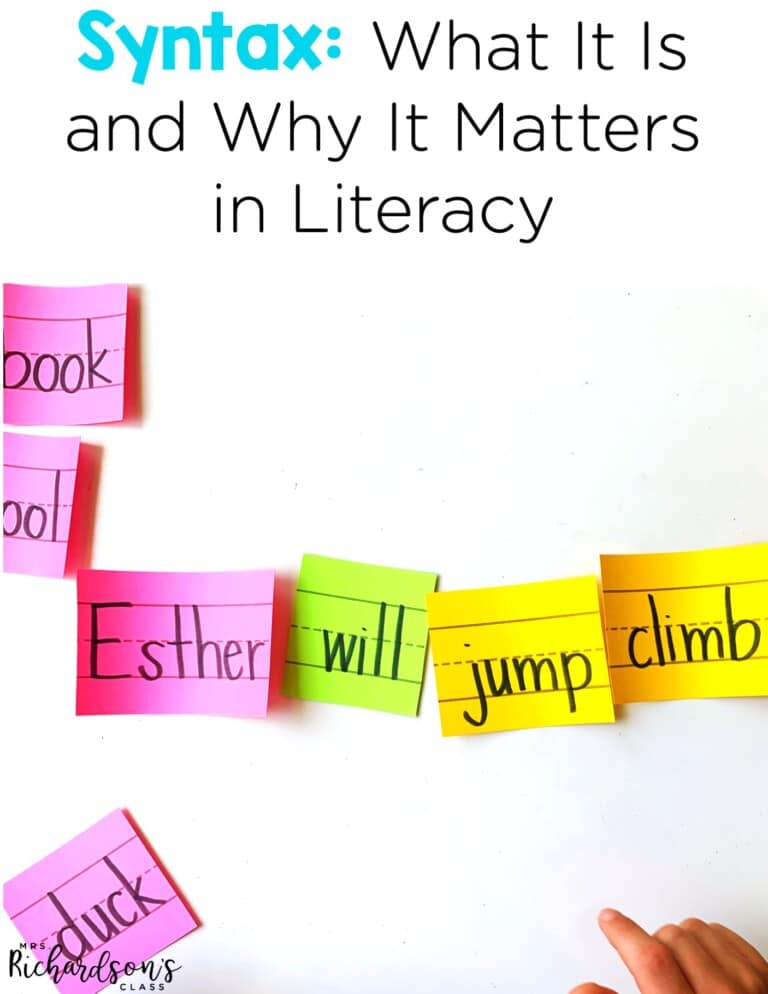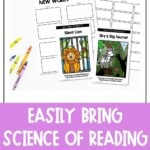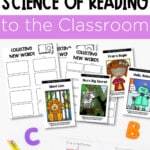


**Amazon affiliate links are used in the post below at no cost to you. This is a small way to support the blog. 🙂
I first heard of the book Shifting the Balance: 6 Ways to Bring the Science of Reading into the Balanced Literacy Classroom by Jan Burkins and Kari Yates as more and more chatter in the teacher world was coming to light about the science of reading research. I have had extensive training in the balanced literacy model, and I love how easy to digest their book is! Additionally, I have seen firsthand how it can be effective and how it really embraces the gradual release model.
But, I have also seen how things can slip through the cracks with my students and my own children. So, when all of this started to surface about the science of reading, I really had to make sure that my heart and head were open to challenging what I was doing and learning a new way to do things if needed. And this is probably no surprise, but I learned so much about better ways to teach literacy.
If you’re newer to understanding the science of reading and what that means for primary classrooms, Shifting the Balance is a great place to start! The authors walk us through six manageable shifts for us to consider in our instructional practices to become better literacy teachers. Let’s recap what they are and what they might look like.
The first shift in Shifting the Balance is to reconsider is that we may be overlooking the role of
listening comprehension in reading comprehension. Readers struggling with comprehension language don’t just need comprehension lessons—they need lots of opportunities to use and develop language and to build knowledge.
So what should we consider if we want to rethink how reading comprehension begins? We need to be sure students hear read alouds on their listening comprehension level. We should also provide plenty of opportunities for language building and talking. These can be both academic conversations and play conversations. Listening comprehension leads to reading comprehension, so get those kids talking!
I have a FREE Vocabulary Collecting recording page for you to use with your readers as you work to find new, exciting words to use to increase vocabulary knowledge. You can get it below!
The common practice they are asking us to reconsider is that we oftentimes take a little bit of
this and dash of that when it comes to our phonemic awareness instruction. We are not as
intentional with it as we should be. The shift they are encouraging teachers of balanced literacy towards is that we need to “commit to intentional, systematic phonemic awareness instruction.”
We need to include more intentional instruction in this area throughout the day. It could be during transition times, in a whole group setting, or even in small groups. Some of the areas the authors suggested to work on include:
To help you implement more phonemic awareness instruction throughout your day, I have two freebies that can help:
The common practice they are asking us to reconsider is that we oftentimes leave too much to
chance with our phonics instruction. We make lots of assumptions—one being that if we taught
them and they can do it then, they automatically retain it.
The shift they are encouraging teachers of balanced literacy towards is to “ explicitly and
systematically teach the secrets of how to crack the written code.” One way to know what to teach is to use a variety of assessments so you know exactly where students are:
Then take the results of these assessments and intentionally provide students opportunities to grow their phonics skills by blending words, building words, studying words, reading words, and writing words.
The fourth shift in Shifting the Balance is to reconsider that we often take a “you just have to
memorize them” approach to teaching high-frequency words. We are reminded that sight words and high-frequency words are not the same, even though many people use them interchangeably.
The shift they are encouraging teachers of balanced literacy towards is to “ create opportunities
for children to “pull apart” the phonemes in high-priority words and match each one to the
grapheme that represents them. We often call this process orthographically mapping words. We want to move away from memorizing and shift towards connecting speech to print, focusing on phonology, and prioritizing high-frequency words for instruction.
The authors share a very helpful list of 109 Power Words to help you plan out what words to teach. Be sure to download it and keep it handy!
The common practice they are asking us to reconsider is that often the strategy of decoding is
used as a last resort. We often want students to consider Does that make sense? Does it sound right? Does it look right? instead of paying close attention to the text.
The shift they are encouraging teachers of balanced literacy towards is to “ prioritize print as a
strategy of first resort for word solving, using meaning and structure to cross-check.” We want to empower our readers to be word detectives and learn how to decode words. Then, we can encourage them to cross-check for accuracy.
Personal note: The bottom line here is that the 3 cueing system is not based on research and we have to rethink the way we have always done things. We cannot be afraid to say, “Sound it out.” and then wait for our early readers to actually do that.
The final shift in Shifting the Balance is to reconsider that oftentimes we can over-rely on
predictable texts to get kids quickly up and reading. I think this is A LOT of what we are hearing
noise-wise with the science of reading, besides phonics instructions needed to take a front seat. Predictable texts can give us a false sense of our students’ reading abilities.
The shift they are encouraging teachers of balanced literacy towards is to “thoughtfully select or
create texts with the decoding opportunities students need to practice.” Decodable readers provide students with an opportunity to explicitly practice the phonics skill they learned or the one they are working on.
I know our guided reading groups typically have used leveled readers in the past, but I want to encourage you to try using decodable books or passages with your readers and see what leaps you see in reading skills.
To help you get started, I have some FREE decodable passages for you to use in your small groups, as well as a few helpful blog posts to guide you through this shift:
If you’re ready to start implementing more of the science of reading as you are shifting the balance in your classroom, here are some resources to help you get started.
Teachers are making the switch from a word wall to a sound wall. Use this Sound Wall to support your readers! You can read more about setting up a sound wall here!
These decodable books also come in digital and passage formats and include scripted lesson plans, phonics word work, parent communication notes, teaching posters, and more! You’ll know exactly what to do during your reading small group lessons with decodable books!
Use these Science of Reading Literacy Stations to keep students engaged while you meet with your reading small groups. This bundle includes 101 centers that cover 12 literacy skills.
Just keep making one small step at a time towards stronger, more intentional literacy instruction. You will see a difference, and your students will benefit. You can do it!

Want to use the latest research to boost your readers during small groups? This FREE guide is packed with engaging ideas to help them grow!

I’m a K-1 teacher who is passionate about making lessons your students love and that are easy to implement for teachers. Helping teachers like you navigate their way through their literacy block brings me great joy. I am a lifelong learner who loves staying on top of current literacy learning and practices. Here, you’ll find the tools you need to move your K-2 students forward!


| Cookie | Duration | Description |
|---|---|---|
| cookielawinfo-checkbox-analytics | 11 months | This cookie is set by GDPR Cookie Consent plugin. The cookie is used to store the user consent for the cookies in the category "Analytics". |
| cookielawinfo-checkbox-functional | 11 months | The cookie is set by GDPR cookie consent to record the user consent for the cookies in the category "Functional". |
| cookielawinfo-checkbox-necessary | 11 months | This cookie is set by GDPR Cookie Consent plugin. The cookies is used to store the user consent for the cookies in the category "Necessary". |
| cookielawinfo-checkbox-others | 11 months | This cookie is set by GDPR Cookie Consent plugin. The cookie is used to store the user consent for the cookies in the category "Other. |
| cookielawinfo-checkbox-performance | 11 months | This cookie is set by GDPR Cookie Consent plugin. The cookie is used to store the user consent for the cookies in the category "Performance". |
| viewed_cookie_policy | 11 months | The cookie is set by the GDPR Cookie Consent plugin and is used to store whether or not user has consented to the use of cookies. It does not store any personal data. |


